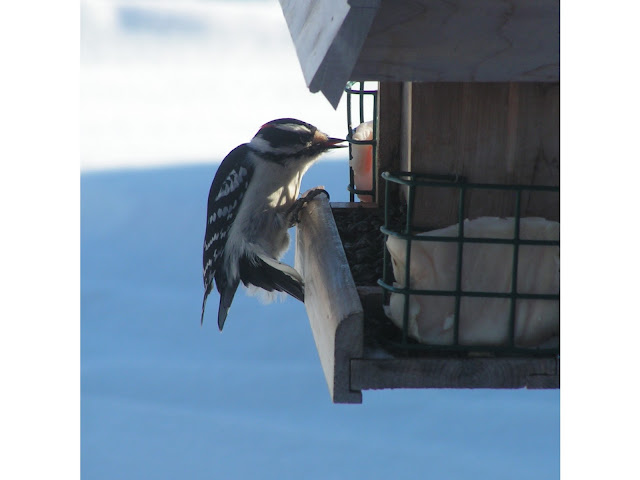 |
| Downy Woodpecker at our Naicam feeder, Feb. 12, 2011. Margaret Madsen photo |
We have no trouble telling Hairy and Downy Woodpeckers apart when they visit our feeders. The Downy guys at about 6 inches (15-18 cms) fit on our small barn feeder with the suet holders at the ends, but the poor gangly Hairy Woodpeckers (9 inches) have an awful time clinging to the feeder to attack the suet. You can see that even this Downy has to skew his tail to the side to brace himself at the feeder.
Both species have almost identical black and white markings and the males both have bright red spots at the back of their heads. It's hard to see the red on the male pictured here. When you see one or the other by itself out in the woods, it's difficult to tell through your binoculars whether you're looking at a Hairy or a Downy. If both species show up at the same time on the same tree, there's no guesswork because you can see the relative difference in size. This has actually happened for me twice in my life - once years ago in BC when we lived on a wooded acreage and once when we lived in Delisle and went on an outing with Saskatoon Nature Society to Blackstrap Provincial Park.
There is another way to tell them apart. Check the bill. The Downy has a short bill while the Hairy's bill is as long as his head. Both bills are strong, straight and chisel shaped so they don't get jammed in the wood when they are excavating Both also have the nasal "whisker" feathers to screen sawdust when they're working.
Both have two toes pointing forward and two back to help them cling to trees and strong, stiff central tail feathers to help prop them up.
When you hear the rat-a-tat-tat sound of a woodpecker beating on wood, it's doing one of three things: excavating a nest, foraging for food or "drumming." They "drum" to attract a mate or to announce their territory and incidentally, both males and females drum. They choose the most resonant "drum" available whether it's a dead tree or a power pole or a metal chimney or the siding on your house!
And here's piece of trivia for you. While all woodpeckers have long, sticky, barbed tongues, the female Downy's tongue is much longer than the male's - she probes and he pecks. And so where do these long tongues go when they retract? Into a channel that curves around the back of the skull and up over the eyes. Is that too much information?
No comments:
Post a Comment